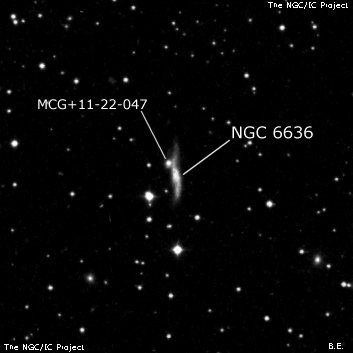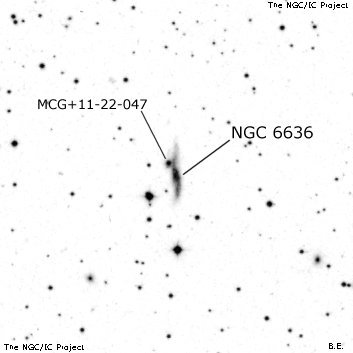NGC/IC Project Restoration Effort
(This is a very very beta version)
NGC6636


Basic Information
Location and Magnitude
Right Ascension: 18:22:2.6
Declination: +66:37:3
Constellation: DRA
Visual Magnitude: 13.7
Historic Information
Discoverer: Swift L.
Year of discovery: 1884
Discovery aperture: 16.0
Observational
Summary description: eeF, pS, R, 3 st nr
Sub-type: Sc
Steve's Notes
=====
NGC 6636
48" (5/5/16): fairly bright, fairly large, warped edge-on 6:1 ~N-S, 1.8'x0.3', bright elongated core. The southern half of the galaxy (including the core region) is slightly bowed out towards the west. The northern extension, though, is subtly convex to the east. So the opposite ends seem slightly misaligned and form a weak integral sign. Adding to the asymmetry, the outer half of northern extension has a much lower surface brightness than the southern arm. MCG +11-22-047 = PGC 61780 is a bright but very compact Seyfert II galaxy, ~10" diameter, just 20" NE of the core and attached to the east edge of the galaxy. It is dominated by a bright stellar nucleus with just a small halo. A mag 11 star is 2.1' due south and a mag 11.5 star (very unequal 6" pair) is 1' SE.
24" (7/21/12): moderately bright, moderately large, very elongated 7:2 ~N-S, 1.1'x0.3', small slightly brighter core. Forms a contact pair with MCG +11-22-047 = PGC 61780, which is attached on the east side of the northern half. The companion was easily visible as a very small "knot", perhaps 10" diameter with a fairly bright stellar nucleus that sometimes dominated the small halo. The core of NGC 6636 (much lower surface brightness than PGC 61780) was close south-southwest of the companion. Two mag 11 stars are 1.2' SE and 2.1' S. An extremely faint, slightly non-stellar glow between these stars is a very close (~5") unresolved pair of mag 16.5-16.7 stars.
17.5" (6/11/88): fairly faint, fairly small, very elongated SSW-NNE, even surface brightness. The compact companion attached at the northeast side was not seen.



